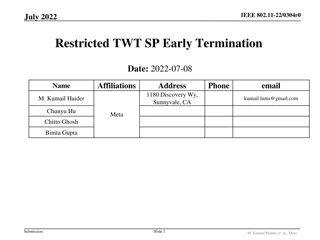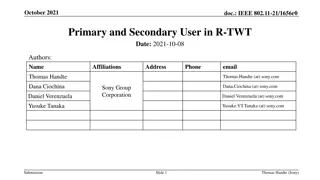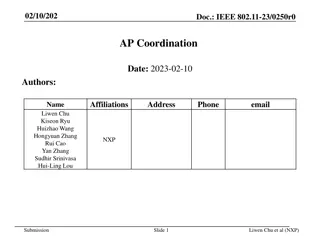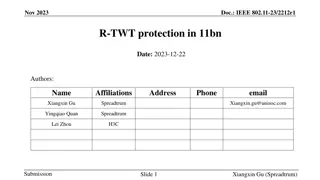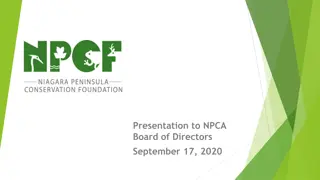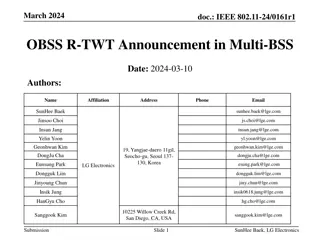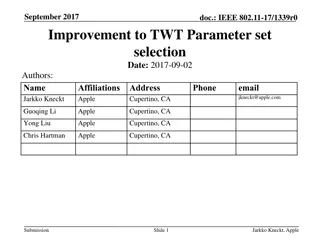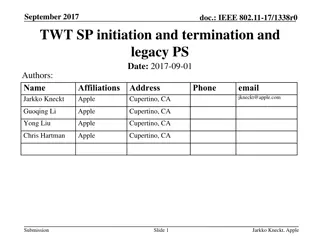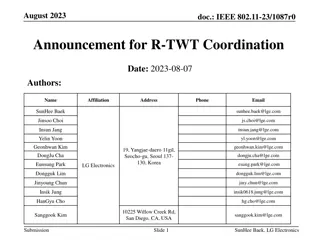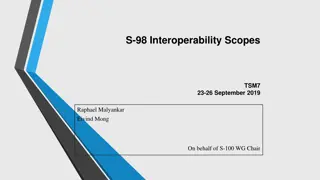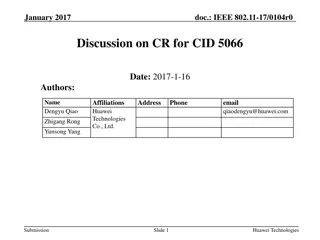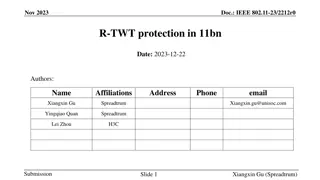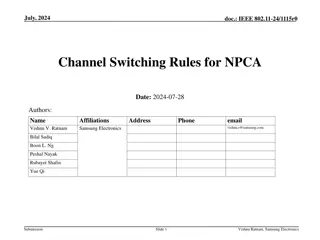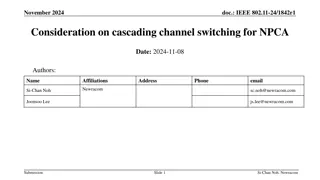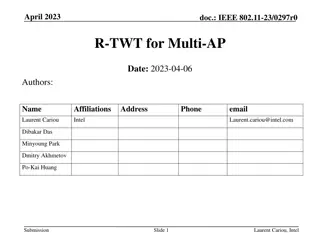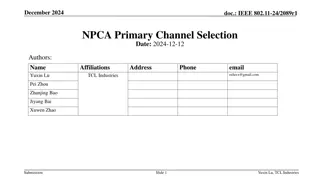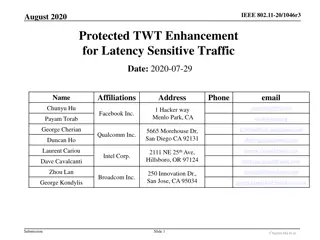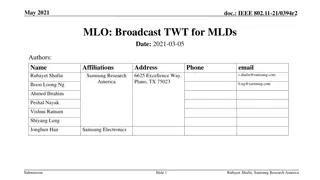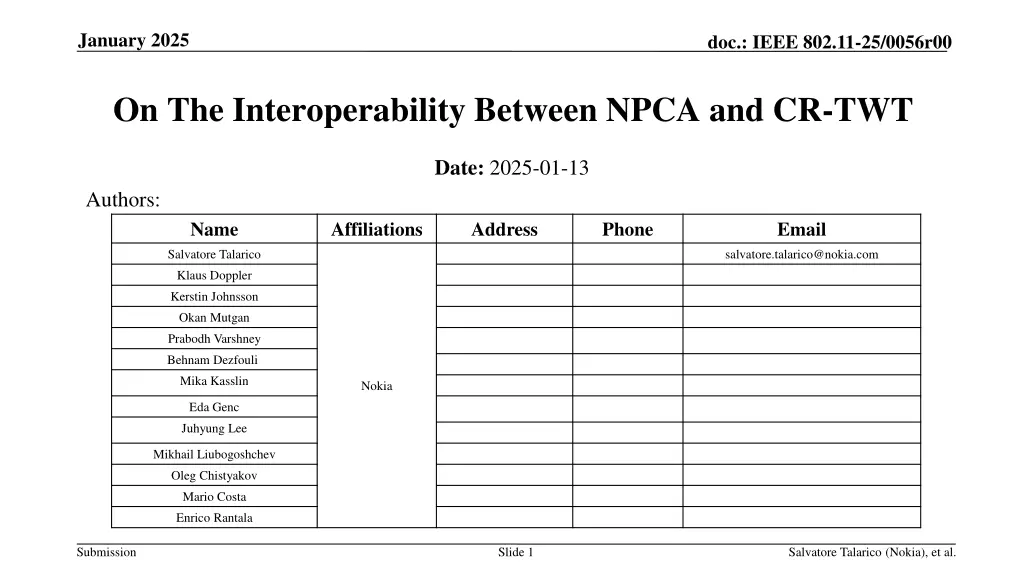
Interoperability Between NPCA and CR-TWT in IEEE 802.11-25
Explore the interoperability challenges between Non-primary Channel Access (NPCA) and Coordinated Restricted Target Wake Time (CR-TWT) features in IEEE 802.11-25 standard. The document discusses the joint operation of NPCA and CR-TWT, focusing on protecting overlapping areas between coordinating Access Points (APs) and different scenarios of NPCA enablement.
Download Presentation

Please find below an Image/Link to download the presentation.
The content on the website is provided AS IS for your information and personal use only. It may not be sold, licensed, or shared on other websites without obtaining consent from the author. If you encounter any issues during the download, it is possible that the publisher has removed the file from their server.
You are allowed to download the files provided on this website for personal or commercial use, subject to the condition that they are used lawfully. All files are the property of their respective owners.
The content on the website is provided AS IS for your information and personal use only. It may not be sold, licensed, or shared on other websites without obtaining consent from the author.
E N D
Presentation Transcript
January 2025 doc.: IEEE 802.11-25/0056r00 On The Interoperability Between NPCA and CR-TWT Date: 2025-01-13 Authors: Name Affiliations Address Phone Email Salvatore Talarico salvatore.talarico@nokia.com Klaus Doppler Kerstin Johnsson Okan Mutgan Prabodh Varshney Behnam Dezfouli Mika Kasslin Nokia Eda Genc Juhyung Lee Mikhail Liubogoshchev Oleg Chistyakov Mario Costa Enrico Rantala Submission Slide 1 Salvatore Talarico (Nokia), et al.
January 2025 doc.: IEEE 802.11-25/0056r00 Introduction During the past IEEE 802.11 Interim and Ad-Hoc meetings, the following two features have been agreed, and their design has been individually discussed ([1-20]) leading to several motions and their related PDT ([10,20]): Non-primary channel access (NPCA) [1-10]: The basic concept is to temporarily utilize an idle alternative channel as a primary channel, called here NPCA primary channel, when the BSS s primary channel is occupied by OBSS or other conditions (bottom left figure). Coordinated Restricted Target Wake Time (CR-TWT) [11-20]: The basic concept is by means of coordination between two APs, it is ensured that when there are overlapping TWT SPs between the two, one AP provides protection of the R-TWT schedule(s) of the other AP, and in particular the APs may ensure that a TxOP ends before the start of the OBSS R-TWT SP (bottom right figure). Submission Slide 2 Salvatore Talarico (Nokia), et al.
January 2025 doc.: IEEE 802.11-25/0056r00 Problem Statement While it is important to focus on the individual design of NPCA and CR-TWT, it is also important to focus on the interoperability between these two features ([19]): When NPCA and CR-TWT are operated jointly, it is important to note that protecting the overlapping area between the R-TWT SPs of two coordinating APs may not be always necessary when NPCA switch happens in one of the associated BSSes, and the operating channels when the reference primary and NPCA primary is used are orthogonal. Example of overprotection when NPCA is enabled jointly with the CR- TWT feature on both coordinating APs. Example of overprotection when CR-TWT feature is enabled on both coordinating APs, but NPCA is only enabled on one BSS. Submission Slide 3 Salvatore Talarico (Nokia), et al.
January 2025 doc.: IEEE 802.11-25/0056r00 Description of Possible General Scenarios When looking at the problem statement in prior slide three general scenarios exist: Scenario #1: BSS A is either not NPCA capable or it is NPCA capable, but it does not have NPCA enabled BSS B is NPCA capable and has NPCA enabled Scenario #2: BSS A is NPCA capable and has NPCA enabled BSS B is either not NPCA capable or it is NPCA capable, but it does not have NPCA enabled Scenario #3: BSS A is NPCA capable and has NPCA enabled BSS A is NPCA capable and has NPCA enabled Submission Slide 4 Salvatore Talarico (Nokia), et al.
January 2025 doc.: IEEE 802.11-25/0056r00 Proposal #1 For deployments falling under scenario #1 (BSS B is NPCA capable with NPCA enabled and BSS A is either not NPCA capable or it is NPCA capable, but it does not have NPCA enabled), when BSS B switches to NPCA primary channel and its operation on the NPCA primary channel continues in the overlapping area between the two SPs, then BSS B shall not truncate the TxOP; BSS B does not switch to NPCA primary channel, then BSS B shall truncate the TxOP. To avoid overprotection in this simple case, during negotiation between the two coordinating APs information related to the primary and NPCA primary channel shall be exchanged including the set of channels used when operating on each of them. Submission Slide 5 Salvatore Talarico (Nokia), et al.
January 2025 doc.: IEEE 802.11-25/0056r00 Proposal #2 For deployments falling under scenario #2 or scenario #3 (BSS A is always NPCA capable with NPCA enabled regardless of BSS B being NPCA capable or not), depending on the NPCA status of BSS A and BSS B an overprotection may occur, but BSS B will not know until the starting boundary of R-TWT SP A. To avoid overprotection in these case, on top of exchanging information related to the primary and NPCA primary channel and the set of channels used when operating on each of them, for trigger-based transmissions AP B could monitor at the starting boundary of R-TWT SP #A for activities from BSS A until it may give up the TxOP: if activities from BSS A are sensed, then AP B truncates the TxOP and won t trigger any more transmissions within the overlapped area between the two R-TWT SPs, otherwise no truncation is necessary. Slide 6 Submission Salvatore Talarico (Nokia), et al.
January 2025 doc.: IEEE 802.11-25/0056r00 Summary In this contributions the interoperability between NPCA and CR-TWT is discussed highlighting that in some cases operating the two features together may lead to an unnecessary overprotection and waste of resources. Some guidelines are discussed by identifying some general scenarios and some possible enhancements to mitigate such issue, and it is proposed that: during negotiation between the two coordinating APs information related to the primary and NPCA primary channel shall be exchanged including the set of channels used when operating on each of them when a BSS (BSS B) is not aware of whether the other coordinating BSS (BSS A) may or may not operate on an orthogonal set of channels and won t interfere each other due to NPCA operation, the AP B shall monitor for a given amount of time (when performing trigger-based transmissions) before truncating the TxOP within the overlapped area between the R-TWT SPs of the two BSSs. Submission Slide 7 Salvatore Talarico (Nokia), et al.
January 2025 doc.: IEEE 802.11-25/0056r00 Straw Poll #1 Do you agree that when NPCA and CR-TWT are operated jointly, protecting the overlapping area between the R-TWT SPs of two coordinating APs may not be always necessary when NPCA switch happens in one of the associated BSSes, and the operating channels when the reference primary and NPCA primary is used are orthogonal? Yes No Abstain Submission Slide 8 Salvatore Talarico (Nokia), et al.
January 2025 doc.: IEEE 802.11-25/0056r00 Straw Poll #2 Do you agree that during negotiation between the two coordinating APs information related to the primary and NPCA primary channel and the set of channels used when operating on each of them should be exchanged? Yes No Abstain Submission Slide 9 Salvatore Talarico (Nokia), et al.
January 2025 doc.: IEEE 802.11-25/0056r00 Straw Poll #3 Do you agree that when a BSS (BSS B) is not aware of whether the other coordinating BSS (BSS A) may or may not operate on an orthogonal set of channels and won t interfere each other due to NPCA operation, the AP B shall monitor for a given amount of time (when performing trigger-based transmissions) before truncating the TxOP within the overlapped area between the R-TWT SPs of the two BSSs? Yes No Abstain Submission Slide 10 Salvatore Talarico (Nokia), et al.
January 2025 doc.: IEEE 802.11-25/0056r00 References [1] IEEE 802.11-23/34, Non-primary channel utilization , Sindhu Verma [2] IEEE 802.11-23/631, Secondary channel usage and secondary 20MHz channel backoff , Liwen Chu [3] IEEE 802.11-23/797, Non-primary channel access , Yongho Seok [4] IEEE 802.11-23/961, UHR secondary channel access , Minyoung Park [5] IEEE 802.11-23/1112, Thoughts on secondary channel access , Insun Jang [6] IEEE 802.11-23/1365, Discussions on non-primary channel access , Sanghyun Kim [7] IEEE 802.11-23/1891, Nonprimary Channel Access Follow-Up , Gaurang Naik [8] IEEE 802.11-23/1911, Secondary channel access and frame transmission , Dongju Cha [9] IEEE 802.11-23/1951, Concurrent CCA for non-primary channel access , Leonardo Lanante [10] IEEE 802.11-24/1762, PDT-MAC-NPCA , Matthew Fischer [11] IEEE 802.11-24/678r2, Coordinated R-TWT Follow Up , Rubayet Shafin [12] IEEE 802.11-23/226r1, Coordination of R-TWT for Multi-AP Deployment , Abdel Karim Ajami [13] IEEE 802.11-23/250r0, AP coordination with R-TWT , Liwen Chu [14] IEEE 802.11-23/291r0, R-TWT Multi-AP Coordination , Muhammad Kumail Haider [15] IEEE 802.11-23/297r0, r-TWT for Multi-AP , Laurent Cariou [16] IEEE 802.11-23/355r0, Enhanced rTWT and MAP operation , Hanqing Lou [17] IEEE 802.11-23/771r0, Coordinated R-TWT Protection in Multi-BSS , SunHee Baek [18] IEEE 802.11-24/827r0, OBSS Interference Impact on CR-TWT and Enhanced Channel Access Rules , Qing Xia [19] IEEE 802.11-24/1577r1, Non-Primary Channel Access During R-TWT Coordination , Leonardo Lanante [20] IEEE 802.11-24/1966, PDT MAC CRTWT , Giovanni Chisci Submission Slide 11 Salvatore Talarico (Nokia), et al.


